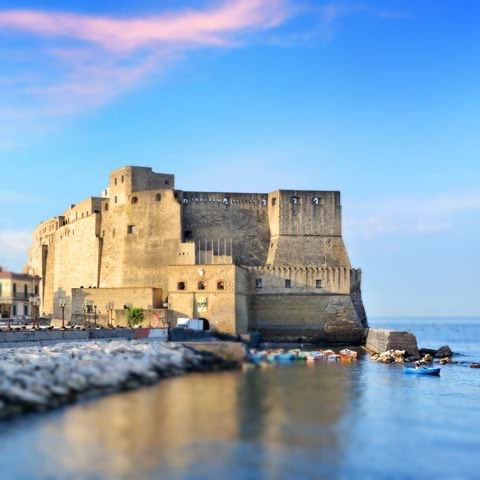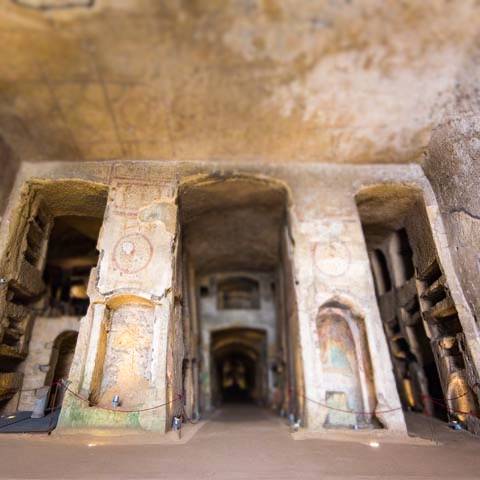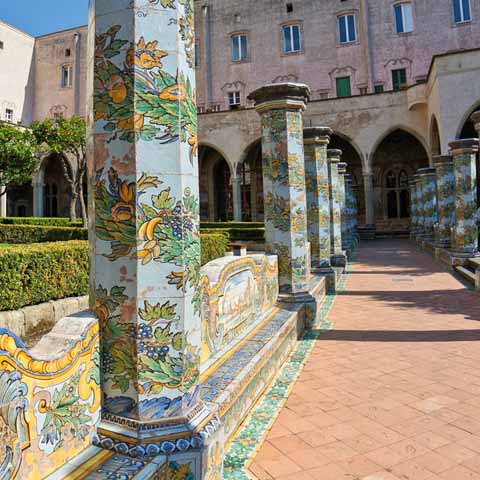Naples is one of the most fascinating cities in Italy. Located on the northern shore of the eponymous gulf, the city is scenically arranged like an amphitheater on two large slopes. The inhabited center occupies the western side of the foothills of the Phlegraean Fields, and in the northeast, it occupies the plain that opens between the Phlegraean Fields and Mount Vesuvius.
Stretching along the coastline at the foot of Mount Vesuvius, Naples presents one of the most urbanized landscapes in the country.
A historical capital of the South and the largest Italian city until the twentieth century, Naples is the center of a vaster area that extends outside the regional borders. The historic city center was declared a UNESCO World Heritage site in 1995, and the city has retained considerable cultural prestige over the centuries.
The seat of important museums and cultural institutions, and the seat of one of the oldest universities in the world, the city presents itself as a lively capital that has preserved most of its secular charm.
A remarkable revival of the city happened in 1994 when Naples hosted the G7 summit. On that occasion, Naples underwent a profound reorganization that re-evaluated the astonishing landmarks like Piazza del Plebiscito, which was completely restored.
But the history of Naples covers a period of several millennia. The place where the first urban agglomeration arose, namely the hill of Pizzofalcone and the surrounding area, attracted many populations over time, and it has been occupied uninterruptedly since the Middle Neolithic era.
Over time, Naples has grown into one of the most important cities of the West, and its history presents itself as a microcosm of European history made up of various civilizations that have left traces in a rich artistic and monumental heritage.
Naples was once the capital of Duchies, States, and Empires. Captured, attacked, and destroyed many times, the city also experienced several natural and man-made catastrophes that reshaped its boundaries and determined the character of its people.
PREHISTORY OF NAPLES
The oldest traces of human presence in the territory of Naples belong to the Middle Neolithic, although it is believed that humanoids inhabited the area from earlier times. The first identified testimonies belong to the Serra d’Alto culture and were found in the current Piazza Santa Maria Degli Angeli. This is the exact place where ancient Naples would rise, between the Acropolis and the Parthenope necropolis, in the inner land of the hill of Pizzofalcone.
In the same area, important artifacts of the Lower Eneolithic and of the Lower Bronze Age were also identified.
Traces from the Middle Eneolithic include evidence of the Gaudo culture, while the ancient Bronze era is also well represented in areas outside of the original boundaries of Parthenope, in the areas of Piazzale Tecchio. In the coastal areas and near the port, archaeological sites are rich in evidence from the Final Bronze era.
The original settlement, called Parthenope, was likely founded by settlers of Cumae in the second half of the eighth century BC, and presumably took its name from the eponymous Siren, whose tomb, according to mythical tradition, was located on the outskirts of the settlements.
Erected on a promontory, the first urban center was placed in a particularly favorable position. Surrounded by the sea on three sides and by the hills of Mount Vesuvius and the Phlegraean Fields on the other side, the settlement was born in a position that allowed direct and efficient control of all traffic by the sea of the Tyrrhenian routes towards Lazio and Tuscany.
But the position also allowed Parthenope to become a safe and well-stocked harbor for all the ships heading towards the Iberian Peninsula, Sardinia, and the Balearic Islands.
The initial port facilities were located at the east of the city, perhaps in the current Piazza del Municipio, on the land that would be used during the Greek re-foundation of the city.
In fact, Parthenope differentiated itself from Cumae right from the start and assumed a competitive position in respect to it.
The re-foundation of ancient Parthenope happened in a climate of stasis forced by Cumae, that was trying to destroy the position of Parthenope. In fact, the settlement served as a refuge for those defeated, and the decisive moment of rebirth corresponds to the establishment of Aristodemus, the tyrant of Cumae, after the battle of Aricia.
Tradition recalls the forced expulsion of the oligarchs who found refuge in Capua, and it is probable that on this occasion the Greeks decided to give space to Neapolis, or the New City. What is certain is that the re-establishment of the city took place on the will of the oligarchs who were motivated by the desire to give life to a second Cumae, quite similar to the city from which they originated. This included the continuation of cults such as that of Demeter, and the faithful recovery of cultural organizations.
Neapolis represented a unique case in the Greek world because it was a city established in the same territory as the original settlement. Indeed, the territory was subdivided in a northern side occupied by landowners and a southern side where the New City was born on the basis of a notable mercantile vocation encouraged by the port.
The New City extended towards the plain between the current Piazza Cavour, San Lorenzo, and Forcella. From a purely urban point of view, Neapolis did not integrate the old city of Parthenope, as was common, but arose a mile and a half away, mainly for logistical reasons. In fact, the place where Parthenope stood did not allow the development of a large urban space. Then, there were the economic and commercial factors that made it more logical to raise a city closer to the Sarno Valley.
In this historical context, the city was composed of two separate centers that constituted a single urban reality.
Magna Graecia saw the potential of the city and granted privileged relationships with Athens. Neapolis inaugurated its hegemonic role in Campania and in the Mediterranean basin. The New City quickly learned how to replace Cumae in the maritime trade and took control over the gulf that became known as the Gulf of Naples.
The commercial success was made possible by the decline of the Deinomenid tyrants of Syracuse, and the abandonment of Pithecusae (today’s Ischia) by the Syracusan garrison due to a violent earthquake followed by subsequent volcanic eruptions.
What followed was an immediate occupation of the island by the city, which led to tensions between Neapolis and Sicily, probably due to the latter’s attempt to gain autonomy over the territories.
But Pericles, sensing the great value of the middle Tyrrhenian, set the basis of a powerful network of maritime relations linked to trade.
The Athenian interest in Campania, but also in Sicily and the Adriatic in general, was due to the need for food; in fact, Greece was mainly interested in the cereal trade due to a constantly growing population. Therefore, trade was oriented towards those areas particularly rich in cereals, with a vision directed towards the complete control of the granary markets.
The effects of the foreign presence in the city were numerous. First, the port area underwent an important development, and new infrastructure linked the city with the surrounding plains suitable for the cultivation of wheat, including Capua, Cumae, and Nola.
But at the same time, the area of the city of Elea saw development of one of the first Italiote communities in the region, who would leave its print on the Greek settlement from an economic and cultural point of view.
The tradition of the Athenian Neapolis is magnificently represented by the famous engraving of Strabo that reports the arrival in Neapolis of the famous Athenian admiral Diotimus. The only obstacle between Greece and its hegemony in Campania was the Syracusan attempt to preserve a primary position in the Tyrrhenian, even after the collapse of the tyrants. And in the long run, this led to clashes between Neapolis and Sicily. But in 415 BC, the expedition against Syracuse ended in a real disaster and the relations between Neapolis and Athens were only attenuated by the inherent events that interested all of Southern Italy.
HISTORY OF NAPLES
The Romans arrived in Naples in the fourth century BC and established a federated city that remained faithful to the Empire during the wars against Pyrrhus of Epirus and Hannibal. However, the Romans did not reciprocate Naples’ loyalty and downgraded the city to a town in 90 BC.
In 82 BC, Naples was devastated by the partisans of Silla with the subsequent development of nearby Pozzuoli. As a result, this refined center of Hellenistic culture was further downgraded to a colony under the Romanization process of Emperor Claudius.
After the fall of the Roman Empire, Naples became the focus of disputes between the Goths and the Byzantines, who conquered the territory between 536 and 553 AD. Shortly afterward, the settlement was transformed by the bishops into an autonomous duchy that managed to remain independent until 1139, when it was conquered by Roger II of Hauteville.
Under the Normans, the city prospered and enjoyed a wide administrative autonomy. Passed to the Swabians after a strenuous resistance, Naples was deprived of all privileges by Frederick II who, nonetheless, endowed the settlement with a prestigious university in 1224. In fact, Naples’ university remained the only one in the South for quite some time.
Then, with the defeat of Manfred in Benevento in 1266, the city passed to Charles I of Anjou and in 1282, after struggles with the Sicilian Vespers, Naples became the capital of the Kingdom of Naples.
Thanks to this role, Naples became an internationally renowned political and cultural center. Yet, heavy taxes and profound social imbalances oppressed development. After decades of struggles and sieges, in 1442, the last Angevin King, René of Anjou, was defeated by Alfonso I of Aragon. Under Alfonso’s rule, the city experienced its most splendid period.
During this time, Naples doubled its population and started to attract local and foreign merchants, officials, writers, artists, Byzantine exiles, and Jews. However, the Aragon dynasty did not enjoy a strong popularity among the locals, especially due to the intrusiveness of Catalan elements in all areas of city life. This did not win over the people with its magnificence, but rather reduced the locals to increasingly miserable conditions.
Starting in 1494, the House of Aragon and House of Anjou fought for control of Naples. Charles VIII of France ruled briefly after expelling Alfonso II of Naples, but was soon forced to withdraw and yielded power to the House of Aragon once more. Eventually, the successor of Charles VIII, Louis XII, attempted to claim Naples once more, leading to a revival of the war between Aragon and France for the Kingdom of Naples. While the House of Aragon officially gained control of the kingdom in 1503, the following decades saw repeated attempts by the French to regain control, which dwindled as time went on. Eventually, the French relinquished all claims in 1559, finally leaving Naples to the Spanish.
Under the Spaniards, the city witnessed a considerable expansion enhanced by the immigration of people from the countryside. Despite this expansion, the period also came with social challenges, including the siege of Odet of Foix, Viscount of Lautrec in 1527 and the insurrection of Masaniello against the Viceroy Ponce de Léon in 1647.
The spread of pestilence in the subsequent years halved the population, then the city was troubled by later events that ended with the War of Spanish Succession. During the war, the viceroyalty of Naples passed to the Austrians, but in 1734 Charles III of Bourbon, the son of Philip V of Spain, forced the Austrians out of the city and set the capital of an autonomous kingdom in Naples.
The reign of Charles III was characterized by an extraordinary splendor; the city was enriched with monuments and attracted many men of letters and arts. A flowering culture helped Naples enjoy the reformist and enlightened politics of Charles III, but also the politics of his successor, Ferdinand IV.
Under Ferdinand, the university was reformed and it was established as a new Academy, as well as the National Library and Museum, the Academy of Science, and the Military College. These bold political and social reforms interested all social classes, but the events related to the French revolution had wide repercussions throughout the Kingdom.
Ferdinand IV participated in the anti-French coalition of 1798 and sent his military force to support the Austrians against the French. However, the French troops pushed the king out of Naples and formed the Parthenopean Republic that resisted for about five months, until King Ferdinand IV returned to Naples, restoring his authority and ending the republic.
But France reacted to the anti-French attitude of Ferdinand IV and occupied the city in 1806. The king retreated to Sicily and Naples passed under the rule of Giuseppe Bonaparte, and then to Joachim Murat in 1808.
Murat brought new reforms to the city, which included the abolition of feudalism and the introduction of the Napoleonic codes.
In 1815, with the fall of Napoleon and the Congress of Vienna, Ferdinand IV returned to the city and soon after assumed the title of Ferdinand I of the Two Sicilies.
Shocked by revolutions and social struggles, the city passed to Francis II who set up a new constitution. But in spite of the retrospective politics of the rulers, the city saw continuous progress in the fields of arts, letters, and technology. In fact, the first steamboat in Italy and the first railway, inaugurated in 1839, were built in Naples.
The Revolution of 1848 concluded with the revocation of the constitution and with the preparation of the liquidation of the Bourbons. But in 1860 Garibaldi entered the city and a popular plebiscite sanctioned the annexation to the state of Savoy, then it was annexed to the Kingdom of Italy soon after its constitution.
Naples gave further proof of heroism during the Second World War when, after more than 120 bombardments, the people forced the German garrison to capitulation. Shook by the war, the city entered a rebuilding phase from the 1950s to the 1980s, which saw the restoration of many major monuments of the city center.
Today, Naples is the third largest city in Italy and has retained its status as one of the most important cities in Southern Italy with an economy based on service industries, manufacturing, and commerce.
The city’s vast wealth of art, architecture, history, cuisine, and scenery have made it a desirable destination for national and international tourism.
ARCHAEOLOGY IN NAPLES
Archaeology is well represented in Naples by open-air sites and numerous archaeological museums. Recent excavations scattered throughout the city, along with necropolises, hold evidence of the prehistoric origins of the settlement.
Important from an archeological point of view is Underground Naples, which is a maze of corridors and ruins buried under the new layers of the modern city. Offering a unique insight into the Roman period, Underground Naples is one of the main attractions of the city.
Another series of underground vestiges is the archeological excavation of San Lorenzo Maggiore. Artifacts from the various eras are exhibited in permanent collections in the National Archaeological Museum of Naples, which is the most important archeological museum in the country, but also in the Archaeological Museum of the Phlegraean Fields.
The Catacombs of San Gennaro, which consist of a series of underground tunnels housing paleo-Christian tombs dating back to the third or fourth century, provide a unique look at Christianity during antiquity.
Also noteworthy is the Paleontology Museum of Naples that houses interesting artifacts and evidence of the first forms of life in the territory.
Near Naples, travelers can learn more about the fateful eruption of Mount Vesuvius in 79 AD and daily life in Ancient Rome prior to the eruption by visiting the archeological sites of Pompeii and Herculaneum. Both sites offer fascinating Roman ruins including streets, houses, and other civic structures. Maggiore is sure to enchant.
Travel Guides
The Campania Region of Italy
The Cities of Campania, Italy








